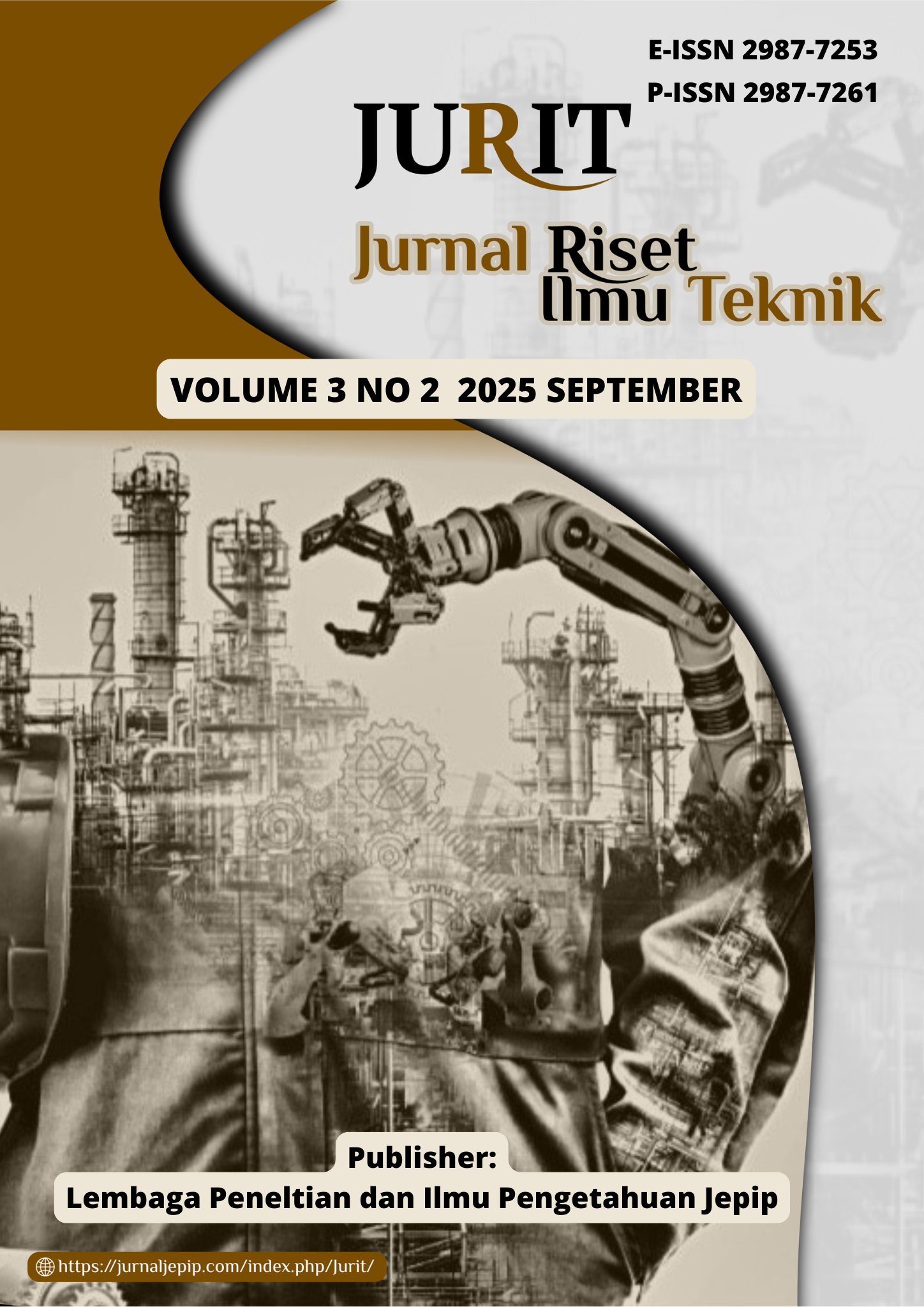Strengthening Institutions and Governance in the Palm Oil Sector for Smallholder Empowerment: A Soft-Structural-Analytical Systems Model
DOI:
https://doi.org/10.59976/jurit.v3i2.181Abstract
This study formulates a model for strengthening the institutions of independent oil palm farmers in Kalimantan through a systemic and participatory approach. The weaknesses of independent oil palm farmers' institutions remain a major obstacle to increasing productivity, competitiveness, and the sustainability of farming businesses. This research method integrates Soft Systems Methodology (SSM), Interpretative Structural Modelling (ISM), and Analytical Hierarchy Process (AHP) to identify key elements, map structural relationships between variables, and determine institutional strengthening strategy priorities. The SSM results show that the root causes of institutional problems include low member participation, weak coordination between parties, and limited access to capital and information. The ISM analysis reveals that government support and farmers' willingness to change are the main driving elements, while professional human resource development and access to capital serve as connecting elements. Meanwhile, the AHP results show that developing partnerships among stakeholders (0.529) is the highest strategic priority, followed by improving organizational management (0.211) and enhancing training and mentoring (0.156). These findings emphasize the importance of synergy between the government, financial institutions, farmer associations, and palm oil companies in building strong, adaptive, and sustainable farmer institutions. Theoretically, this research contributes to the development of an integrated systems approach in strengthening agricultural institutions in Indonesia, particularly in the smallholder palm oil sub-sector.
Downloads
References
D. Ntawuruhunga, “Climate-smart agroforestry systems and practices: A systematic review of what works, what doesn’t work, and why,” 2023. doi: 10.1016/j.forpol.2023.102937.
V. Agarwal, “Coping with public-private partnership issues: A path forward to sustainable agriculture,” Socio Econ. Plan. Sci., vol. 89, 2023, doi: 10.1016/j.seps.2023.101703.
F. A. Kitole, “Digitalization and agricultural transformation in developing countries: Empirical evidence from Tanzania agriculture sector,” Smart Agric. Technol., vol. 7, 2024, doi: 10.1016/j.atech.2023.100379.
B. Aslam, “AMR and Sustainable Development Goals: at a crossroads,” 2024. doi: 10.1186/s12992-024-01046-8.
A. M. Thakker, “Sustainable Development Goals for Textiles and Fashion,” 2023. doi: 10.1007/s11356-023-29453-1.
C. McCarthy, “Can Drones Help Smallholder Farmers Improve Agriculture Efficiencies and Reduce Food Insecurity in Sub-Saharan Africa? Local Perceptions from Malawi,” Agric. Switz., vol. 13, no. 5, 2023, doi: 10.3390/agriculture13051075.
G. B. Simpson, “An African perspective on the Water-Energy-Food nexus,” Sci. Rep., vol. 13, no. 1, 2023, doi: 10.1038/s41598-023-43606-9.
E. Siankwilimba, “Bioecosystems towards sustainable agricultural extension delivery: effects of various factors,” 2024. doi: 10.1007/s10668-023-03555-9.
E. Nkansah-Dwamena, “Why Small-Scale Circular Agriculture Is Central to Food Security and Environmental Sustainability in Sub-Saharan Africa? The Case of Ghana,” Circ. Econ. Sustain., vol. 4, no. 2, pp. 995–1019, 2024, doi: 10.1007/s43615-023-00320-y.
C. Cholez, “Heterogeneity of inter-organizational collaborations in agrifood chain sustainability-oriented innovations,” Agric. Syst., vol. 212, 2023, doi: 10.1016/j.agsy.2023.103774.
J. Koiwanit, “Stakeholder collaboration for solid waste management in a small tourism island,” PLoS One, vol. 18, no. 7, 2023, doi: 10.1371/journal.pone.0288839.
A. S. Fernandez-Bou, “Water, environment, and socioeconomic justice in California: A multi-benefit cropland repurposing framework,” Sci. Total Environ., vol. 858, 2023, doi: 10.1016/j.scitotenv.2022.159963.
A. L. Musungu, “Production, consumption, and market supply of edible crickets: insights from East Africa,” Agric. Food Econ., vol. 11, no. 1, 2023, doi: 10.1186/s40100-023-00272-9.
U. Das, “Measures of livelihoods and their effect on vulnerability of farmers to climate change: evidence from coastal and non-coastal regions in India,” Environ. Dev. Sustain., vol. 26, no. 2, pp. 4801–4836, 2024, doi: 10.1007/s10668-023-02911-z.
M. Verma, “Sustainability in residue management: a review with special reference to Indian agriculture,” 2024. doi: 10.1007/s10333-023-00952-8.
B. Lahiri, “Designing a user-centric mobile-based agro advisory system for sustainable development of smallholder farming systems in the eastern Himalayas, India,” Inf. Technol. Dev., vol. 30, no. 4, pp. 665–695, 2024, doi: 10.1080/02681102.2024.2327860.
P. Aseete, “Public–private partnership generates economic benefits to smallholder bean growers in Uganda,” Food Secur., vol. 15, no. 1, pp. 201–218, 2023, doi: 10.1007/s12571-022-01309-5.
E. G. Kedisso, “Sustainable access of quality seeds of genetically engineered crops in Eastern Africa - Case study of Bt Cotton,” 2023. doi: 10.1080/21645698.2023.2210134.
S. Stetkiewicz, “Crop improvements for future-proofing European food systems: A focus-group-driven analysis of agricultural production stakeholder priorities and viewpoints,” Food Energy Secur., vol. 12, no. 1, 2023, doi: 10.1002/fes3.362.
D. Onwude, “Bottlenecks in Nigeria’s fresh food supply chain: What is the way forward?,” 2023. doi: 10.1016/j.tifs.2023.04.022.
D. Weraikat, “Data Analytics in Agriculture: Enhancing Decision-Making for Crop Yield Optimization and Sustainable Practices,” Sustain. Switz., vol. 16, no. 17, 2024, doi: 10.3390/su16177331.
M. Ayamga, “Developing Institutions and Inter-Organizational Synergies through Digitalization and Youth Engagement in African Agriculture: The Case of ‘Africa Goes Digital,’” Land, vol. 12, no. 1, 2023, doi: 10.3390/land12010199.
M. R. Cherubin, “Carbon farming initiative: A national-scale public-private partnership to promote regenerative agriculture in Brazil,” Exp. Agric., vol. 60, 2024, doi: 10.1017/S0014479724000255.
L. M. Mungai, “The role of agricultural extension services in promoting agricultural sustainability: a Central Malawi case study,” Cogent Food Agric., vol. 10, no. 1, 2024, doi: 10.1080/23311932.2024.2423249.
R. F. Datoon, “Bridging and bonding social capital for sustainable technology adoption, the Landcare program in the resource poor rural town of Claveria, Philippines,” Res. Glob., vol. 7, 2023, doi: 10.1016/j.resglo.2023.100152.
V. Touch, “Adaptation constraints and prospects for future research priorities in lowland rice-based farming systems: learning experiences from Northwest Cambodia,” Environ. Dev. Sustain., vol. 26, no. 9, pp. 22555–22586, 2024, doi: 10.1007/s10668-023-03566-6.
N. Khurshid, “An assessment of asymmetric impact of financial stability and agricultural subsidies on agricultural production in Pakistan,” J. Agribus. Dev. Emerg. Econ., 2024, doi: 10.1108/JADEE-10-2023-0248.
Downloads
Published
How to Cite
Issue
Section
License
Copyright (c) 2025 Valentina Febi Gurning, Yance Bernat, Gusman Adiyat, Viktor Kusri

This work is licensed under a Creative Commons Attribution 4.0 International License.

















